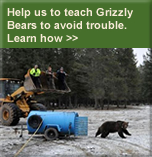
Overview
|
Education: Teaching bears to avoid human settlementsEvery year in BC, problem grizzly bears are killed by residents or Conservation officers because they have learned to seek out food near or at human settlements. In the Trans-border area, reducing these bear deaths is one of the most important actions we can do to improve grizzly bear conservation status. Many of these deaths are preventable if the attractant that brought the bear to a particular area is secured and made unavailable to the bear. Too many bears are dying in our backyards causing population declines, inhibiting recover. Wildlife managers in NW Montana have been successfully ‘teaching” grizzly bears to avoid home sites and farms by using special hazing techniques. Here in BC we are just starting to use these methods. The Trans-border Grizzly Bear Project has been working with the regional Conservation Officers in the South Selkirk and Purcell Mountain areas to haze potential problem bears away from settlements. It is important that we intervene in these events before a bear has received too much of a food reward. Bears that have learned to get easy human-based food over a period of time are too difficult to rehabilitate. But if we get to the bear early enough, it works pretty well. So, it is important that we have a relatively quick response to a potential bear problem. We encourage residents to call the Conservation Office wildlife conflict hot Line 1-877-952-7277 if they have a grizzly bear in their yard or farm. Most bears that are attracted to human food sources are sub-adults that are in the process of exploring how to make a living on their own, or bears that are experiencing trouble getting enough food due to a natural food shortage when the local berry crop fails. During these periods of exploration bears can be attracted to human-food sources and get into trouble. As bear conflict managers in Montana have been doing for many years, if these bears are captured and provided with a negative stimulus, they often learn the error of their ways and avoid human settlements in the future. For example, in the 2009 bear season, we used these techniques on 2 bears, one young female and another young male. Both bears were radio collared and hazed and have stayed in the wilder portions of our area for the duration of the non-denning season. This program requires the cooperation of the local residents, they have to call the Conservation Officer Service as soon as a bear moves into their area. Each potential conflict situation is assessed for the chances of success and a decision is made on a course of action. While most bears can be taught to avoid people, not all can and a few may have to be killed. We are both learning, the bears are learning to avoid people, and we are learning how to coexist with bears. |
